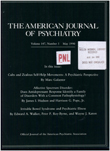Comparison of MRI and CT scans in a group of psychiatric patients
Abstract
The authors compared the results of computerized tomography (CT) and magnetic resonance imaging (MRI) scans of 16 psychotic patients with various diagnoses whose neurologic examinations suggested structural brain abnormalities. Blind readings showed a high concordance of findings, including ventricle-to-brain ratios, although MRI appeared superior in visualizing midline structures and identifying atrophic changes. Because it requires no ionizing radiation, MRI allows multiple studies of the same patient, study of family members, and recruitment of unbiased samples of control subjects. Use of MRI may help address questions regarding the specificity and prevalence of brain abnormalities observed with CT in psychotic patients.
Access content
To read the fulltext, please use one of the options below to sign in or purchase access.- Personal login
- Institutional Login
- Sign in via OpenAthens
- Register for access
-
Please login/register if you wish to pair your device and check access availability.
Not a subscriber?
PsychiatryOnline subscription options offer access to the DSM-5 library, books, journals, CME, and patient resources. This all-in-one virtual library provides psychiatrists and mental health professionals with key resources for diagnosis, treatment, research, and professional development.
Need more help? PsychiatryOnline Customer Service may be reached by emailing [email protected] or by calling 800-368-5777 (in the U.S.) or 703-907-7322 (outside the U.S.).



